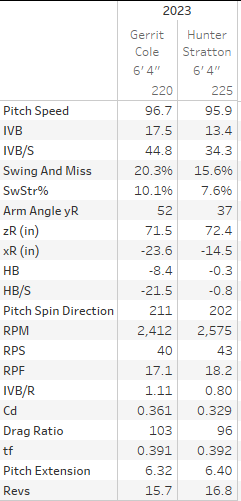Hunter Stratton is almost Gerrit Cole But Is Also Entirely Not Gerrit Cole
How Tiny Differences Can Be Mountains
Let’s pretend for a second that we have no prior knowledge of any players, and we’re told to investigate the baseball talents of two pitchers, one named Gerrit Cole, the other Hunter Stratton.
Both players were drafted by the Pittsburgh Pirates, and each stands roughly 6’4” / 220 lbs. They both have high spin fastballs, and they both average around 96 MPH with their fastballs, with about 6.3 to 6.4 feet of extension. Stratton’s fastball clocks in with an impressive 43 revolutions per second (2575 RPM if you must multiply it by 60), compared to Cole’s 40 RPS. In fact, Stratton averages 16.8 revolutions per pitch, a full revolution more than Cole does. Cole’s fastball takes about 0.391 to reach the plate; Stratton’s reaches the plate on average 0.001 seconds later, at 0.392 seconds.
An elite pitcher like Cole maximizes each revolution, with a robust 1.11 inches of induced vertical break per revolution (1.11 IVB/R), whereas Stratton only gets about 0.8 IVB/R, and therein lies the difference between an elite fastball, and a very poor one, by major league baseball standards.
Let’s put the numbers down into one metric-laden chart:
Essentially, they have very similar fastballs and builds, except that Cole releases his wider and lower, and it gets much more rise.
Let’s Talk Drag
I’ll have a lot more to say about drag forces. For now, the important concept is that drag is a key force in ball movement. Some of that is environmental (think Coors Field), but some of that is generated by the pitcher creating turbulence, likely due to seam shifted wake effects. I’m not a physicist (not even close), so I’m mostly just guessing at the why of things, but I can see what the data say.
Each pitcher is unique, so the interactions with their release aren’t easily generalizable. It’s clear that Cole can generate plus drag on his pitch, and likely also benefits from greater spin efficiency (us in the public don’t have a direct way of measuring this).
Optimizing Stratton’s Fastball Spin Axis
A fastball with 180 degree spin is pure vertical, but that pitch won’t have as much “rise” when thrown from anything other than a fully overhand slot, a la James Karinchak.
We don’t have a ton of data on Stratton, but his AAA data suggest he may have more success going for a spin axis closer to 215 degrees. My data are all unadjusted; I don’t have a great explanation of why Stratton’s fastball had so much less rise in the majors than in AAA. Incidentally, that’s pretty much where Cole sits with his fastball from a spin axis perspective.
Just Throw it like Cole?
Cole releases the ball about 1 inch lower and 9 inches wider than Stratton does, with a an average Spin Axis of roughly 210 degrees. My recommendation to Hunter, on the off chance that he reads this, is to try to mimic everything that Cole does on his fastball, from release height and side, to seam orientation to hand position, and see if it can unlock his fastball. That’s obviously easier said than done, but these tiny tiny differences are the difference between a future Hall of Famer, and a guy who signed a minor league deal as a free agent.
There are very few humans who can throw 95-96 MPH and also spin a ball at over 43 revolutions per second.
Ray Black, Come Back!
Of course, there is more to throwing a fastball than throwing it hard and spinning it, but the list of humans who can do it at Stratton’s level is quite small. Data include some Single A pitchers like Cade Winquest, who can really spin a fastball.
The names within 1-2 mph of Stratton are guys like Jackson Jobe, Jared Jones and Dylan Cease, but also Jack Hartman and Chad Sobotka.
So is Stratton Like Really Good?
Not with his current fastball.
BUT, he represents to me a tremendous test case for pitch optimization. Can he tweak his mechanics just that ever so slightly? If he does, will his fastball start playing like Cole’s? Hunter, get yourself to Driveline, or some other pitching lab, and try some stuff out. As is, your fastball is unusable, but the ingredients (velo & spin) are top notch.
Let’s Talk About The Cutter
Stratton gets his best results with the cutter. It’s “only” a 91 mph pitch, but he can fill the zone with it and not get crushed. The fastball with its current shape, is the root of his problems. If he can’t fix it, throw the cutter a lot more.
My data have a bug with respect to foul tips, so my totals may not match what you’ll see on some other sites.
In fact, once he hit the majors, he upped his usage of the cutter significantly compared to AAA.
What’s The Point of All This?
I think Stratton is a phenomenal example of how minute the differences are between an absolute monster of a pitcher, and a guy that is struggling to be a viable bullpen arm, in terms of raw “Stuff”. My current philosophy with respect to pitching prospects is that everyone’s malleable. “Stuff” can be developed, and frankly, I’m surprised that we don’t see every single pitcher trying to optimize all of their pitches. If Stratton can find “just” 4-5 inches of induced vertical break, he’s suddenly a top notch, potential closer.






